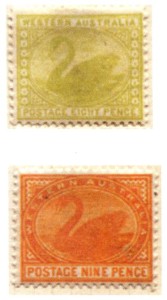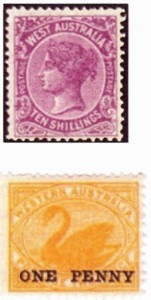by Brian Pope
Illustrations: The 3d, 6d, 8d, 9d, 1/-, 10/- stamps and PC 20, EN 7, EN 8, EN 9, WR 6, are by courtesy of The Western Australian Museum. The others are from local private collections. – Originally produced for the PSWA Centennial National Stamp Exhibition (2012) Catalogue – images have deteriorated through various reproductions – The webmaster would appreciate finer copies if they are available that may be reproduced with permission.
Two factors, the decision by the Commonwealth Government in late 1910 to issue a uniform stamp design, and the introduction of an Australian base letter rate of 1d on 1 May 1911, had a major influence on collecting in 1912. The first generated a significant reduction in stocks of 2d ‘State’ material by surcharging, whilst the second reduced general usage of 2d denominated stamps and postal stationery.
Last usage of three De La Rue plates
De La Rue despatched their ½d, 3d, 5d, 6d and 1/- surface printing plates to Melbourne on 22 August 1902. Of these, the 3d, 6d and 1/- plates were put to press for the last time in 1912. All plates were destroyed at the Stamp Printing Branch, Commonwealth Treasury, Melbourne, on 2 July 1913. 
3d. Orange Brown. The original De La Rue 240-on plate made in 1872 was bisected in Melbourne circa 1906-07. A 120-on plate was put to press in 1912. The last three printings were on the new pre-gummed CrA paper which is noticeably thinner than the earlier CrA paper. Known from 30-11-12.
6d. The CrA paper in general use did not fit the De La Rue plate layout very well so South Australia’s ‘Crown over Single-lined A’ paper was used. The watermark is always Sideways Right indicating that the sheets were bisected before printing. Perforation was by the new 12 x 11½ Double Vertical Comb machine made by James Southcott and intended for Adelaide but delivered to Cooke in Melbourne. Known from 9-04-12.
1/-. Green. The stamp production details are the same as for the 6d. Known from 25-03-12.
1/-. Line perforation 12½. Five examples currently on record. Two of these, including this one, are cancelled by MOO SANDSTONE Type D, 10-06-12 and another is dated either 21 or 24-??-?? A fourth is cancelled MANINGA MARLEY, near Sandstone. The fifth is in the Queen’s Collection. Two strips of three were reported in 1918-1919. The two stamps dated 10-06-12, appear to be the first (this one) and the third (Walkley Collection), from a vertical strip of three.
 Last usage of two Melbourne Plates
Last usage of two Melbourne Plates
8d. Intended for the 1lb interstate parcel rate. The design was derived from the De La Rue ½d postcard die, enlarged to 23.5mm x 19.5mm. The ‘Oliver’ proofs used for the 8d and 9d are illustrated in Hamilton and Pope, (1979, 330). Their present whereabouts are not known. Known from 20-04-12.
9d. Intended for the basic telegram rate. The design was derived from the Melbourne 4d. The shade is that of the 3rd printing but the watermark is upright. Known from ??-07-12.
Inventory Reduction

10/-. This design was based on Charles Naish’s Victorian 3d. It was first printed in 1902 in mauve and again in 1905 in this vivid,
distinctively different shade. Both printings were on VCr paper. This shade was eventually issued from 15-04-12.
ONE PENNY on 2d. The final surcharge for Western Australia. Stocks of the 2d in 1912 were estimated to suffice for more than two years! Consequently a combined total of 1,278,000 stamps still in Melbourne and 600,000 returned from Perth, were surcharged. Issued in Perth, 6-11-12

